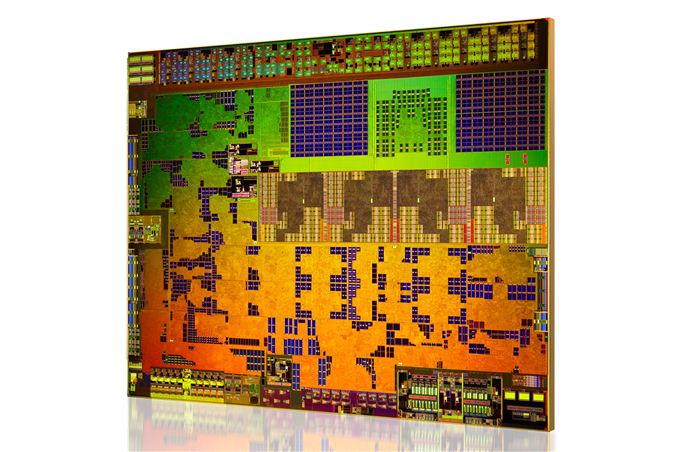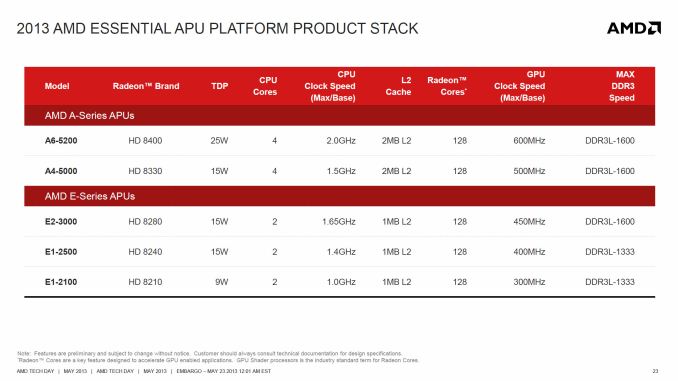The AMD Kabini Review: A4-5000 APU Tested
by Jarred Walton on May 23, 2013 12:00 AM EST
Anand is covering AMD’s latest Kabini/Temash architecture in a separate article, but here we get to tackle the more practical question: how does Kabini perform compared to existing hardware? Armed (sorry, bad pun) with a prototype laptop sporting AMD’s latest APU, we put it through an extensive suite of benchmarks and see what’s changed since Brazos, how Kabini stacks up against Intel’s current ULV offerings, and where it falls relative to ARM offerings and Clover Trail. But first, let’s talk about what’s launching today.
AMD has a three-pronged assault going out today: at the bottom (in terms of performance) is their 2013 AMD Elite Mobility Platform, formerly codenamed Temash. The main subject of this review is the newly christened 2013 AMD Mainstream APU Platform, aka Kabini. And at the higher end of the spectrum we’re also getting the Richland update to Trinity, which AMD is calling their 2013 Elite Performance APU Platform. We’ll cover all of these with Pipeline pieces, but here’s the overview of the Kabini parts:
In total there are five new Kabini APUs launching: one 25W part, three 15W parts, and one 9W offering. The hardware is the same from the architectural side of things, with the A-Series parts coming with four Jaguar CPU cores and supporting DDR3L-1600 while the E-Series will be dual-core with DDR3L-1333 on two of the models and DDR3L-1600 on the highest performance option. The GPUs in all cases will be fully enabled 128 core GCN architecture parts, but clock speeds range from 300MHz on the 9W part up to 600MHz on the 25W part, with the 15W parts filling in at clocks of 400-500MHz.
AMD provided plenty of material to discuss, and as usual there’s a lot of marketing material that we don’t need to get into too much. For those of you that want to see the AMD slides, though, here’s the full Kabini presentation gallery. Or if you're really interested, I've put the full 2013 Mobility Platforms deck into our galleries.

















130 Comments
View All Comments
Musafir_86 - Thursday, May 23, 2013 - link
-Finally!-BTW, some pictures still missing/not loading...
-Thanks for the article, but when Anand's architectural deep-dive will come out?
Regards.
Musafir_86 - Thursday, May 23, 2013 - link
-Sorry, I missed the link on the main page, and all pictures load correctly now.Thanks.
codedivine - Thursday, May 23, 2013 - link
Kabini looks interesting. Somewhat surprised that the max bandwidth (10.5 GB/s) supported is less than even Exynos 5 Dual (12.8GB/s).Wondering whether the GPU supports fp64 and at what rate?
codedivine - Thursday, May 23, 2013 - link
I guess Anand answered the fp64 question in the other article already :)axien86 - Thursday, May 23, 2013 - link
Wow...the AMD Jaguar Temash and Kabinis cost about the same as Atoms (~$30-$50) and perform many times faster than Atoms.
I wonder why Anandtech did not compare the Kabinis against Atoms/Celerons instead of i3 and i5 that cost around $200 to $225+ ?
JarredWalton - Thursday, May 23, 2013 - link
Sadly (not really -- Atoms are trash), we don't have any recent Atom/Celeron/Pentium laptops around. No one has ever sent us a Celeron or Pentium laptop for review, and the last Atom netbook we tested was probably almost two years back. Anand does have Clover Trail covered, but there's no real point in running our heavy laptop suite on that.JDG1980 - Thursday, May 23, 2013 - link
In the mini-ITX DIY segment, Kabini may compete against the Celeron 847 boards (which currently run about $75). I'd be interested to see how it stacks up there. The AMD solution would have a clock speed advantage (847 only runs at 1.1 GHz) but the Sandy Bridge-based 847 almost certainly has better IPC.MrMilli - Thursday, May 23, 2013 - link
Here you go: http://www.computerbase.de/artikel/prozessoren/201...BushLin - Friday, June 21, 2013 - link
Thanks for that, my German isn't great but from what I can tell this chip is a great choice compared to Intel's actual competing products. Such a shame Anand's review is with a Pentium consuming over twice the power and i5/i7 products costing many times more.My interest is in the low power desktop boards and hope to see a useful comparison on here at some point. I'm sure Zotac or some other manufacturer with such a leaning would be happy to supply comparable boards to cover Kabini and the lower power Pentium and Celerons.
jagd - Thursday, May 23, 2013 - link
Dual channel may not help to CPu but you are forgetting GPu , this is a shame for anandtech .